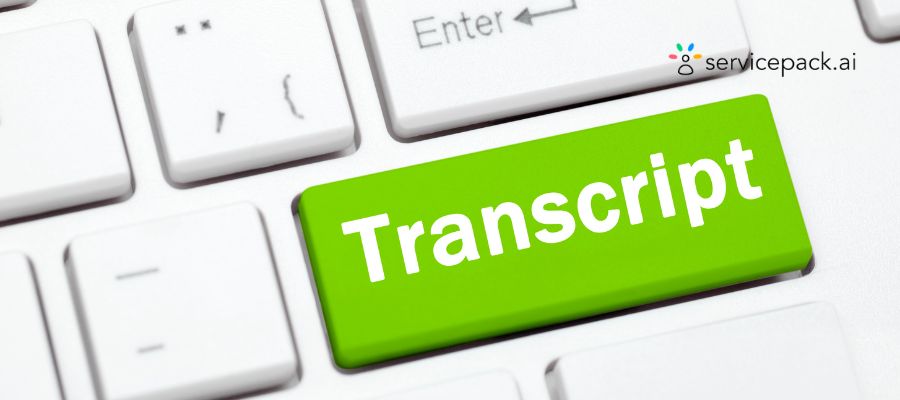In schools and universities, lectures play a vital role in delivering knowledge and helping students understand various subjects. However, for some students, keeping up with the fast pace of spoken lectures or understanding complex terms can be challenging.
This is where real-time Speech-to-Text (STT) technology comes to the rescue. By transcribing lectures and classroom discussions in real-time, STT technology makes education more accessible and inclusive for everyone.
Meaning of Lecture Transcriptions
Lecture transcriptions refer to the written representation of spoken content from lectures, presentations, or discussions in educational settings. This process involves using technology, such as Speech-to-Text software, to convert spoken words into written text in real time. Lecture transcriptions aim to make educational content more accessible to a broader audience, including students with hearing impairments, language challenges, or different learning styles.
These transcriptions capture the spoken information accurately, allowing students to read along with the spoken words as they are being delivered. By providing a written record of the spoken content, lecture transcriptions facilitate better note-taking, comprehension, and review of educational materials. They enhance the learning experience by accommodating various needs and preferences, promoting inclusivity, and supporting efficient knowledge retention.
What is Real-Time Speech-to-Text Technology?
Real-time Speech-to-Text technology, also known as automatic speech recognition, is a remarkable advancement in the world of communication. It converts spoken language into written text instantaneously.
This technology has found applications in various fields, including education. In educational settings, real-time STT is used to transcribe spoken content such as lectures, discussions, and presentations into text, allowing students to read along with what is being said in real-time.
The Benefits of Real-Time Lecture Transcriptions
Accessibility for All
Real-time lecture transcriptions are a game-changer for students with disabilities. Those who are deaf or hard of hearing can now access lectures without relying solely on sign language interpreters. Similarly, students with auditory processing difficulties can better comprehend the content by reading along while listening.
Language Learning and Comprehension
In educational institutions with diverse student populations, where English might not be the first language for everyone, real-time transcriptions can aid language learning. Students who are still improving their language skills can read the transcribed content to better understand and grasp the subject matter.
Review and Study
Lecture transcriptions provide a valuable resource for students to review and study. They can refer back to the transcribed content to reinforce their understanding of complex topics, ensuring they didn’t miss any crucial information during the lecture.
Note-Taking Enhancement
Even students without disabilities can benefit from lecture transcriptions. Instead of struggling to jot down every word the professor says, students can focus on understanding the concepts and later refer to the transcription for more detailed note-taking.
Accommodation for Different Learning Styles
Every student has a unique learning style. Some students learn better by reading, while others learn better by listening. Real-time transcriptions cater to both types of learners, making the learning experience more effective and engaging.
Inclusion of Remote Learners
In the wake of recent global events that led to increased remote and online learning, real-time lecture transcriptions have gained even more significance. Students participating in virtual classrooms can benefit from transcriptions, as they might face connectivity issues or language barriers that hinder their learning experience.
Implementing Real-Time Lecture Transcriptions
Integrating real-time lecture transcriptions into educational settings involves the following steps:
Choosing the Right STT Technology
Educational institutions need to choose the appropriate Speech-to-Text technology that suits their requirements. Factors such as accuracy, real-time capabilities, and compatibility with existing systems should be considered.
Setting Up the Transcription System
The chosen STT technology needs to be integrated into the classroom setup. This may involve installing microphones or utilizing existing audio equipment to capture the lecturer’s voice clearly.
Testing and Fine-Tuning
Before implementing real-time lecture transcriptions on a broader scale, it’s essential to conduct thorough testing. This includes assessing the accuracy of transcriptions, making adjustments for background noise, and ensuring that technical glitches are minimized.
Providing Access to Students
Once the system is in place and tested, students should be informed about the availability of real-time transcriptions. They should receive guidance on how to access the transcriptions and use them effectively.
Continuous Monitoring and Improvement
The implementation process doesn’t end with the initial setup. Regular monitoring of the technology’s performance is crucial. Feedback from both students and educators can help identify areas for improvement and ensure that the transcriptions remain accurate and helpful.
Challenges and Considerations
While real-time lecture transcriptions offer numerous benefits, there are challenges that educational institutions should be aware of:
Accuracy and Technical Limitations
Achieving perfect accuracy in real-time transcription can be a challenge, especially in noisy classroom environments or with speakers who have accents. Technical limitations can result in occasional errors that might affect the overall learning experience.
Privacy Concerns
Transcribing lectures involves capturing and processing spoken words, which raises privacy concerns. Institutions need to ensure that student privacy is respected and that the transcriptions are used for educational purposes only.
Cost and Resource Allocation
Implementing real-time transcription technology requires investment in terms of both technology and human resources. Institutions need to consider these costs and allocate resources accordingly.
Training and Familiarization
Educators and students might need training to effectively use the real-time transcriptions. Familiarity with the technology is essential to fully reap its benefits.
Final Thoughts
In the ever-evolving landscape of education, technology continues to transform the way we learn and teach. Real-time Speech-to-Text technology stands as a prime example of how innovation can make education more accessible and inclusive. Educational institutions open doors to a wider range of students, ensuring that learning is not hindered by disabilities, language barriers, or learning preferences by providing real-time lecture transcriptions.
While challenges exist, the potential benefits make the integration of real-time STT technology into educational settings a step toward a more inclusive and effective learning experience for all.

